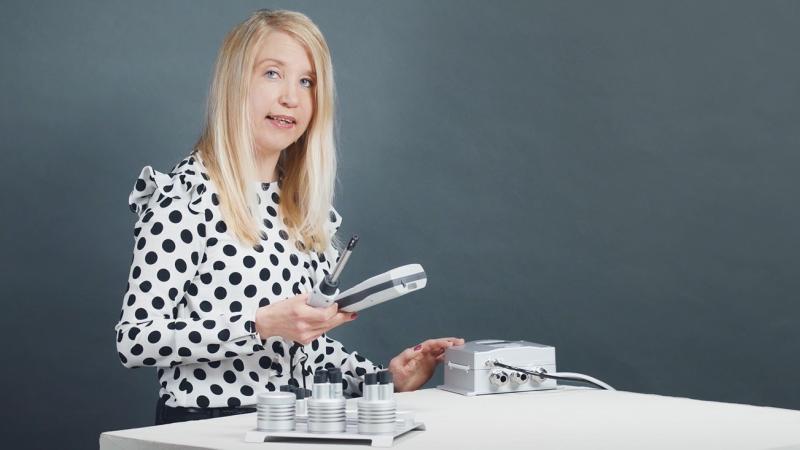Einpunktkalibrierung vor Ort – die schnelle und einfache Option
Es gibt viele Möglichkeiten, die Kalibrierung und Justierung von Messgeräten für die relative Feuchte anzugehen. Idealerweise sollten alle Messgeräte in akkreditierten Labors nach den höchsten Standards überprüft und zertifiziert werden. Tatsächlich müssen wir Zeit, Kosten, technische Anforderungen, Fachwissen und die einzigartigen Anforderungen jeder einzelnen Anwendung in Einklang bringen.
Benutzer*innen fragen Hersteller häufig nach einem empfohlenen Kalibrierintervall. Dies ist ein vernünftiger Ausgangspunkt, wenn Sie darüber nachdenken, wie oft Sie Ihre Messgeräte kalibrieren sollten. In der Praxis kann sich aber die Leistung eines Messgeräts je nach Bedingungen, unter denen es verwendet wird, unterschiedlich schnell verschlechtern. Es ist daher wichtig, ein geeignetes Kalibrierintervall festzulegen.
Hinsichtlich der Kalibrierung gibt es mehrere Möglichkeiten: Sie können Ihr eigenes Kalibrierlabor einrichten, Ihre Messgeräte zur Laborkalibrierung an Dritte einsenden oder selbst eine Vor-Ort-Prüfung oder Einpunktkalibrierung im Prozess durchführen.
Bei der Einpunktkalibrierung vor Ort kommt ein Gebrauchsnormal zum Einsatz, um ein stationäres Messgerät zu kalibrieren, ohne es außer Betrieb nehmen zu müssen – wenn z. B. Techniker*innen ein tragbares Gerät verwenden, um einen an der Wand befestigten Messwertgeber zu überprüfen. Der Hauptvorteil dieser Methode ist, dass sie sowohl schnell als auch einfach ist. Es gibt weder Ausfallzeiten für das stationäre Messgerät, noch ist ein Zusatzaufwand für Demontage und erneute Montage erforderlich. Der Nachteil dieses Verfahrens ist jedoch das Fehlen eines zweiten Kalibrierpunktes, um die korrekte dynamische Ansprechzeit des stationären Messgeräts anzuzeigen. Wenn die gemessenen Bedingungen über einen kurzen Zeitraum stabil bleiben, kann es ausreichend sein, den Sensor leicht anzuhauchen und die Ansprechzeit und Wiederherstellung des Messgeräts zu beobachten. Bei stark schwankenden Messbedingungen empfehlen wir eine Mehrpunktkalibrierung.
Das Vaisala HUMICAP portable Feuchte- und Temperaturmessgerät HM70 wurde für anspruchsvolle Feuchtemessungen in Anwendungen zur Stichprobennahme entwickelt. Es eignet sich auch ideal zur Vor-Ort-Prüfung und -Kalibrierung von stationären Vaisala Feuchtemessgeräten. Die folgenden Messwertgeber können mit dem HM70 kalibriert werden: HMDW60/70, HMW61/71, HMD/W20/30, HMP130, HMP230/240 Serie, HMT320/330 Serie, HMM210 Serie und DMW19.
Achten Sie bei der Kalibrierung vor Ort darauf, den Messwert eines stationären Messwertgebers mit einer kalibrierten Referenzsonde, die an das HM70 angeschlossen ist, zu überprüfen und zu justieren. Ein- oder Zweipunktkalibrierungen können an Industriemesswertgebern und -modulen (HMP230/240 Serie, HMT320/330 Serie und HMM210 Modulen) mit einem Vaisala Anzeigegerät MI70 und dem HMK15 Feuchtekalibrator von Vaisala durchgeführt werden.
Im folgenden Video erfahren Sie, wie Sie eine Einpunktkalibrierung und -justierung im Prozess für den Vaisala HMT330 mit einem Vaisala HM70 durchführen. Weitere HMT330 Kalibrieralternativen finden Sie hier.


Comment
Adjustment and calibration
Calibration means comparing the instrument reading with a reference. Adjustment is correcting the instrument to minimize deviation from the calibration reference. It is important to understand calibration uncertainty when deciding whether or not to make adjustments to your measurement equipment. The amount of calibration uncertainty varies depending on multiple factors, including temperature differences, the thermal mass of the instrument, and the measurement technology used. For this reason, it may not be wise to make small adjustments, because you may end up adjusting the random error and adding noise to your measurements as a result
Single-point calibration vs. multi-point calibration:
In single-point calibration, the calibration is performed at one point against the working standard by placing the reference instrument as close to the unit under calibration (UUC) as possible. It is important to allow sufficient stabilization time so that there is a temperature equilibrium between the working standard and the UUC. Single-point calibration is an effective way to maintain a sensor’s performance in applications where the operating conditions do not vary greatly. Sensors that operate at a stable temperature, humidity, pressure, and so on are ideal candidates for single-point field calibration.
Using a working standard and generator or chamber, which is able to produce various points enables the user to perform multi-point field calibration. The difference between one-point field calibration and multi-point field calibration is that the UUC must be removed from the process.
Laboratory calibration vs. field calibration
Laboratory calibration is the most accurate method of calibrating measurement equipment. It offers lower uncertainties than field calibration, environmental effects are minimal, and the number of factors that can influence the calibration process is significantly reduced. Field calibration provides the opportunity to perform rapid checks and diagnostics without the need to remove measurement equipment.
Handheld devices are especially good for quick pass/fail checks, but with a bit of extra care and attention, they can also be used to perform single-point calibration and adjustments in the field.
The GMP regulations specify only that sensors should be calibrated, and do not provide any guidance as to the specific calibration method. It is up to you to decide which calibration method is suitable for your application and will provide you with confidence in your measurements. Auditors and clients may have preferences or requirements of their own that exceed the GMP regulations, so you should have a solid rationale, including a risk assessment, for any calibration method you choose. If you have questions about the benefits and risks of a given calibration method, your best course is to consult a metrologist for advice.
Best regards,
Sanna Lehtinen and Paul Daniel
Our dewpoint probes contain DRYCAP sensor. Unfortunately, DRYCAP sensor is not sold as a spare part as it is not easy to replace. You may either send your existing probe to Vaisala service center for sensor replacement (Select CRS Product | Vaisala Store) or buy a new dewpoint probe. If you are referring to our humidity products, then we do have INTERCAP sensor that is user changeable: INTERCAP® Humidity Sensor 15778HM | Vaisala Store. It is compatible with following product: HMD40, HMD50, HMW40, HMW50, HMD42, HMW53, HMW80, HMP60, HMP50, HUMITTER, HMD60Y, HMD60U, HMD70U, HMD70Y, HMT330.
Neuen Kommentar absenden